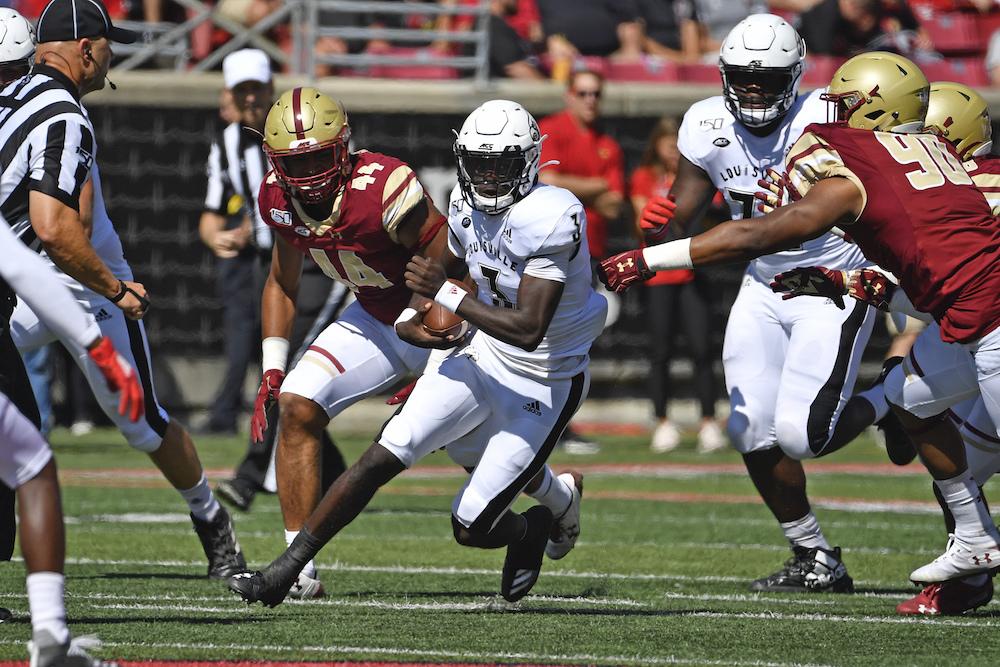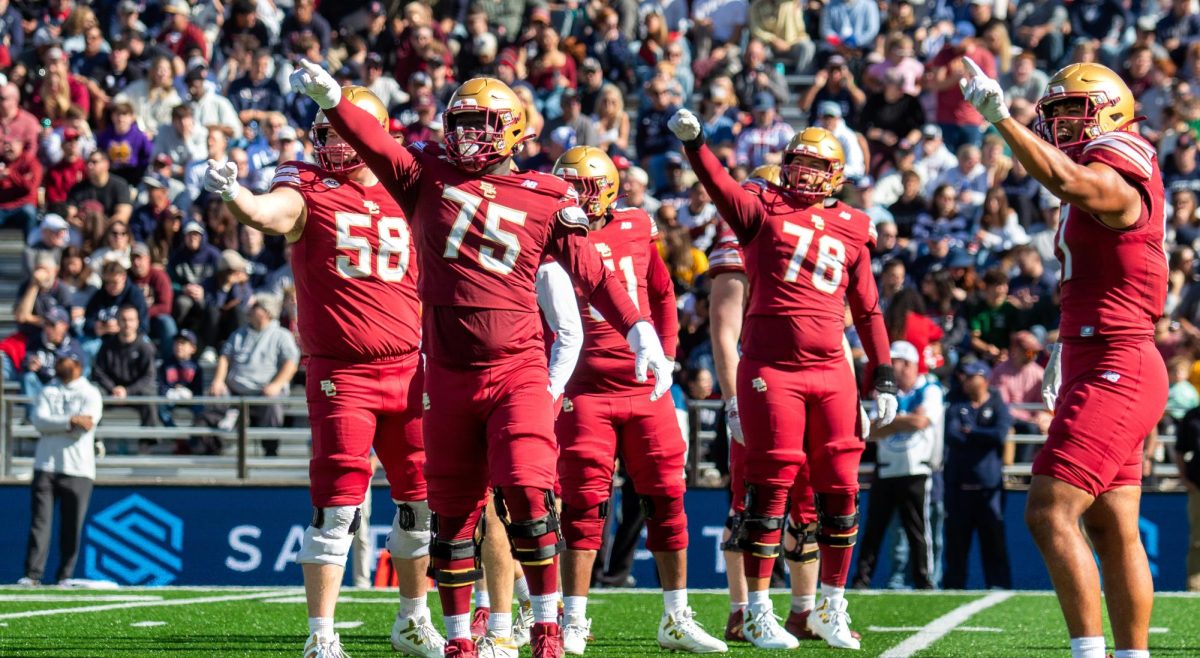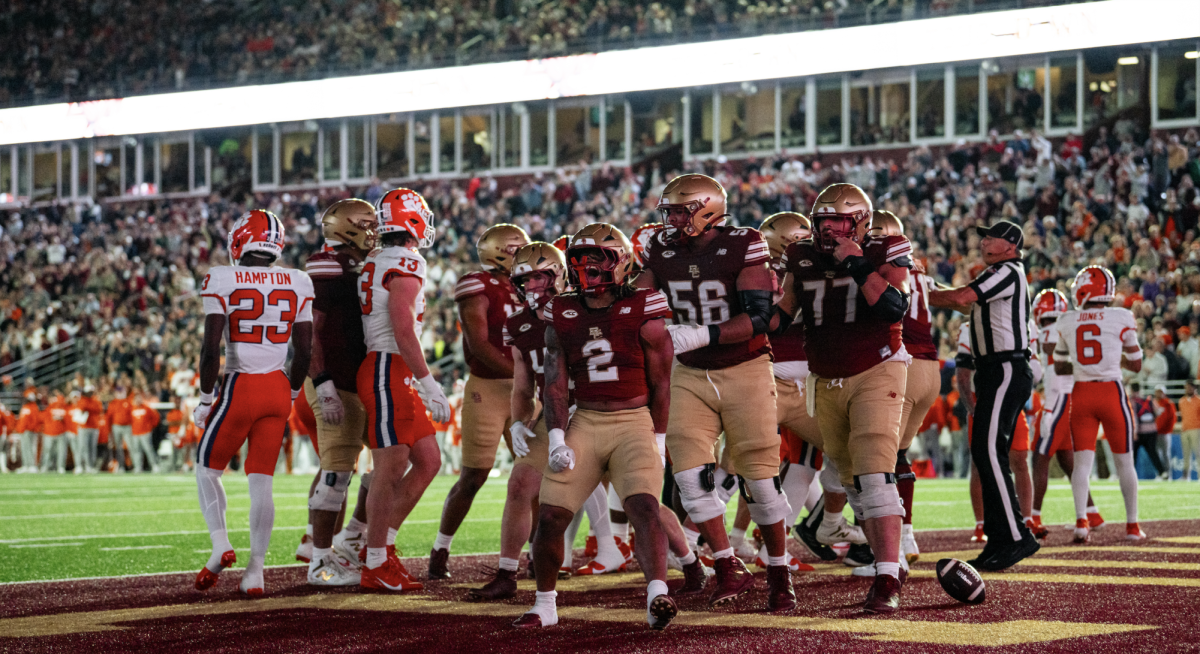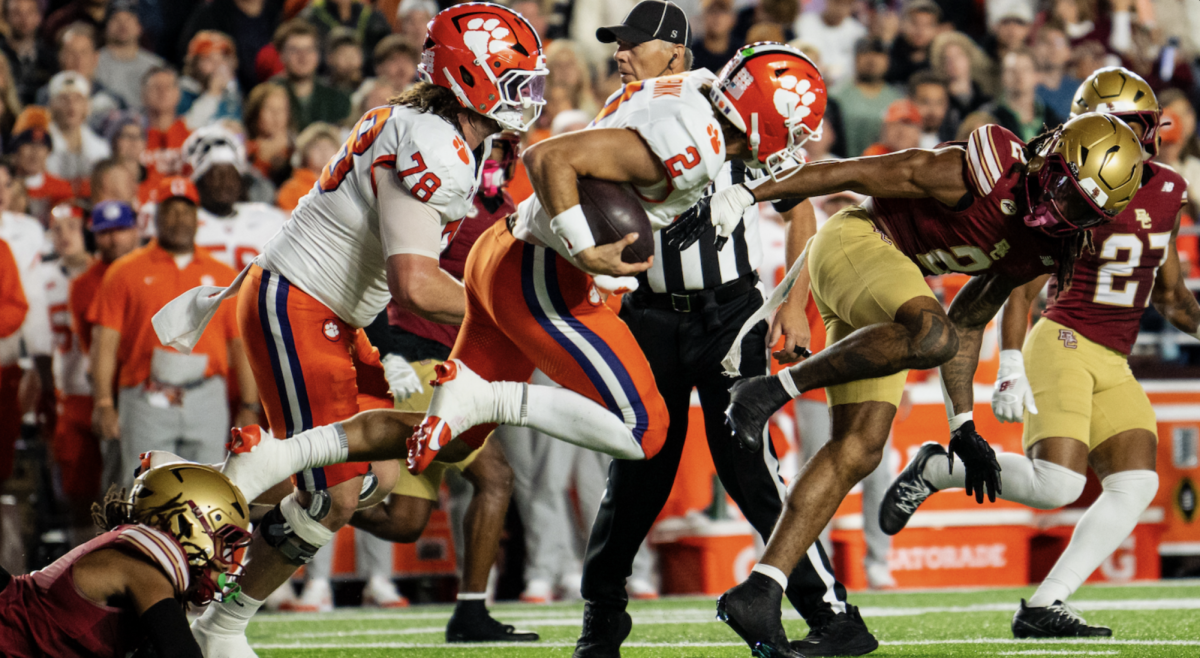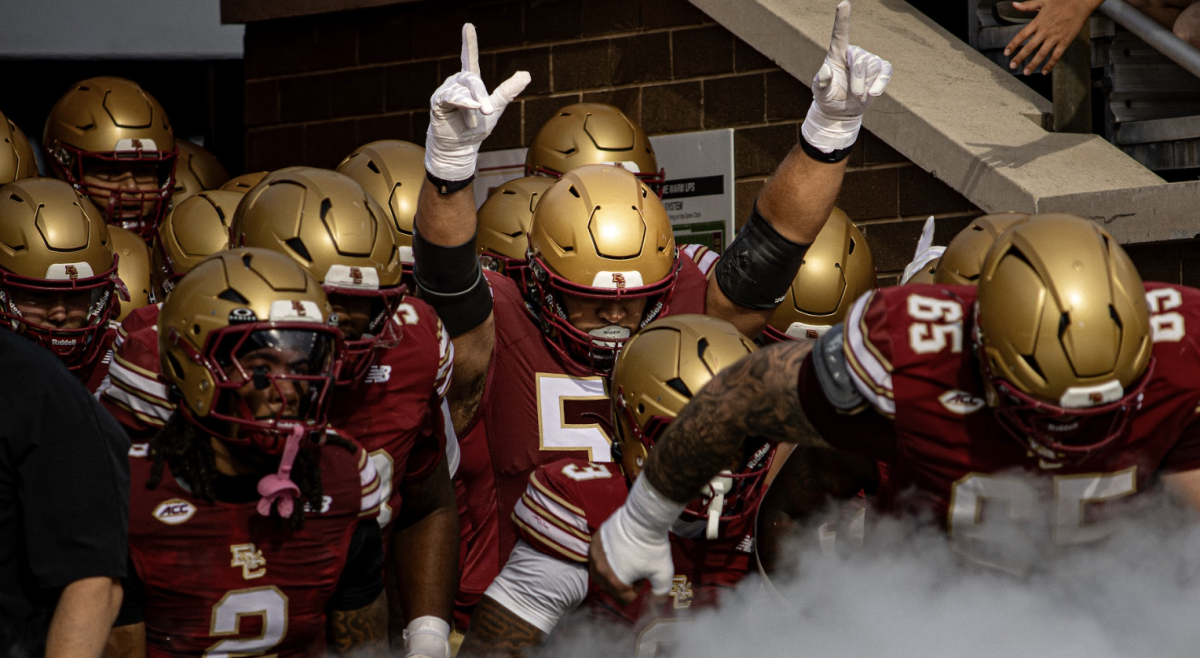In 2015, Boston College football went just 3-9, the worst record that head coach Steve Addazio has posted during his time in Chestnut Hill. That season, though, with defensive coordinator Don Brown leading the way, the Eagles were fourth in the country in scoring defense (15.3 points per game). The unit boasted the likes of Justin Simmons, John Johnson, Matt Milano, and Harold Landry—all of whom have gone on to have success in the NFL.
The problem was the offense, as BC finished 121st of 125 teams in scoring, managing a meager 17.2 points per game. Having two units at such extremes is not a winning recipe, and Brown jumped ship to Michigan the following year.
This season, as was reflected in the team’s shootout loss to Louisville on Saturday, the Eagles have seen their units trade places. The offense has been more than up to par, ranking third in the ACC in total yardage while averaging 32.8 points per game. The defense? It’s been nothing short of porous. With new defensive coordinator Bill Sheridan running the show, BC has surrendered 400-plus yards in four of six games, ranks last in the ACC in yards allowed, and is second to last in scoring defense. All in all, the play of the defense through six games and the difficult home stretch of the schedule has the Eagles headed for their first missed bowl game in four years and a similar letdown to that difficult 2015 campaign.
Yes, the BC lost a tremendous amount of talent this offseason: Three-fourths of its secondary, three-fourths of the defensive line, and a talented middle linebacker all left the Heights. In total, the Eagles returned just 38 percent of its defensive production, good for 128th in the country. Still, every team in college football faces turnover, and there’s no reason for the unit to have struggled as much as it has. After all, a handful of tenured BC players have stepped into starting roles this season, so it’s not like it is over-reliant on freshmen—it’s floundering with players that have been around the program for years.
This exodus of talent and further step backward was a long time coming, though. After Brown left, the Eagles have regressed on the defensive side of the ball each season, and that was even with the likes of NFL starters Landry and Zach Allen. From 2016 to last season, Jim Reid’s defense went from Brown’s No. 1 mark in the nation in yards per game (254.3) to 70th, at over 400 per game. To make things worse, coming into this season, another BC coach headed to Jim Harbaugh’s Michigan—defensive backs coach Anthony Campanile—and the Eagles went from a potential “defensive backs university” to a position group plagued with issues.
Perhaps most frustrating is that the team’s defense looked better against Wake Forest last week, allowing 440 yards but holding the high-flying Demon Deacons and Jamie Newman to 27 points—well below their season average of 38. Sheridan was creative with packages and the defense adjusted quickly to the strange, delayed handoff that Wake Forest used. But, like they did against Kansas in Week 3, the Eagles took a colossal step backward against the Cardinals.
The 41-39 loss to Louisville was the latest indictment of a unit that is plagued by missed tackles, coverage breakdowns, and an inability to pressure opposing quarterbacks. The Cardinals—despite coming in having lost their last nine conference games—piled up 664 yards of offense, the highest total the Eagles have ever given up. Yes, ever. Scott Satterfield’s Louisville had nine more yards than Miami managed against BC back in 1984 during the Hail Flutie game. Now, BC clocks in at 118th in yards allowed per game (476.2), 12 spots short of the nation’s worst mark.
It didn’t take long for the Cardinals to set the tone of the game, too. On the second play of the game, Micale Cunningham stepped back in a clean pocket and delivered a 23-yard strike to Dez Fitzpatrick, who immediately spun out of an attempted tackle from Mehdi El-Attrach. Two plays later, BC had eight men in the box but couldn’t slow down Louisville’s Javian Hawkins—he ran right around the left side and rumbled 47 yards until El-Attrach finally dove and dragged him down. That was just the first drive. Louisville racked up chunk yardage left and right, with seven different players registering plays of 10-plus yards.
BC struggled for a variety of reasons. Cardinals quarterbacks Micale Cunningham and Evan Conley combined to complete 23-of-34 (68 percent) of their passes for 428 yards, good for 12.6 yards per completion. This was the product of a clean pocket, with the duo taking their time to pick out receivers downfield. There was no drop-off between the two, either, as they both were able to carve up the Eagles defense.
“We had two different quarterbacks coming in and you really couldn’t tell,” Satterfield said after, per Louisville Athletics. “We didn’t miss a beat whoever was in the game, quarterback-wise. We didn’t turn the ball over offensively. Just a lot of good things on the offensive side of the ball.”
Countless plays can be pointed to as examples of shaky defense. El-Attrach had a tough day, as in the first quarter, he seemed frozen as Seth Dawkins ran right by him and caught what would be a 59-yard touchdown reception—and this was after getting juked by Cunningham in the backfield on a quarterback keeper. Then, near the end of the first half, a pair of linebackers—John Lamot and Joe Sparacio—were in zone coverage and had no chance to catch Dawkins, as he ran a simple corner route and went 77 yards with ease. Mismatched coverages were a recurring trend—Fitzpatrick caught a pass three yards downfield and scampered for a 23-yard score after defensive end Brandon Barlow attempted to cover him but didn’t have the speed to handle a crossing route. This popped up again on one of the biggest plays of the game, as a 3rd-and-10 for Louisville was converted in the fourth quarter when defensive end Marcus Valdez was tasked with covering Tutu Atwell, one of the fastest wide receivers in the conference. The result was predictable: A Louisville first down.
Louisville running backs and wide receivers made BC’s defensive ends and linebackers look silly, keeping drives alive at will. After letting Wake Forest go 17-for-24 on third down attempts last week, the Eagles promptly surrendered an 8-for-16 mark to the Cardinals. To make things worse, Louisville didn’t enter with high marks on third down, as they entered ranked 117th in the country This was more of a problem in the opening three quarters, and BC dug a deficit as a result.
Ultimately, that brings us to a tough question: What’s next? The Eagles have been playing without linebacker Isaiah McDuffie, but at this point it seems he might end up a medical redshirt. Plus, it’s not like that is the position that’s causing the most issues, as Max Richardson has easily been the defensive MVP and Lamot and Sparacio have both played well. There’s als0 the fact that good linebackers can only do so much for you, as without pressure or good coverage, they’ll just rack up tackles on chunk plays. There aren’t reinforcements coming for the secondary or defensive line, two problematic position groups for BC thus far.
One potential outcome could be that Sheridan’s time as defensive coordinator will be short-lived. The linebackers coach was promoted over Jim Reid this spring, but his defensive game planning has left a lot to be desired. A mideason move is far from likely, but it’s not out of the question. Just take a look at Wake Forest and Jay Sawvel last season. Head coach Dave Clawson fired Sawvel on Sep. 23 after the Demon Deacons slumped to 2-2 and had given up 97 points in their last two games while also ranking 121st in yards allowed per game.
Still, that’d just be a band-aid, and it’s unlikely to happen. Sheridan and the Eagles need to take a long, hard look at what they’re doing. El-Attrach may be an established graduate student, but with the way he played against Louisville, BC should look elsewhere on the depth chart. Jason Maitre, a redshirt freshman, has worked his way into a starting role, and it might be worthwhile to follow his example and work more players in. Addazio and Sheridan might as well use players like Shittah Sillah and Izaiah Henderson, as it surely can’t get worse than Saturday’s debacle and maybe they’ll hit on something. Burning redshirts is always a delicate issue, but the simple fact is that the Eagles are unable to get any pressure on opposing quarterbacks, struggle to contain, and get picked apart through the air. Why not shuffle things up and try and find a more successful combination?
The Eagles need to fix mental mistakes and tackling issues, and they need to do it fast. They have a brutal, back-loaded schedule, and the fact that they’re letting the likes of Kansas and Louisville run all over their defense is incredibly troublesome when you consider the offenses they’ll be up against later this year. Clemson, North Carolina State, and Florida all rank in the top half of the ACC in total offense while Notre Dame is averaging just under 40 points per game.
If nothing changes, BC is headed toward a season similar to 2015. That season’s offense was derailed by injuries at quarterback, but with the way Dennis Grosel played—he threw for three touchdowns and guided the Eagles’ to a go-ahead field goal attempt—and the potent running game the Eagles have, it’s hard to see a massive step back there. So, unlike 2015, the issue this time isn’t the offense or injuries, it’s a defense that pretty much hasn’t been able to stop anybody.
Featured Image by Timothy D. Easley / AP Photo

